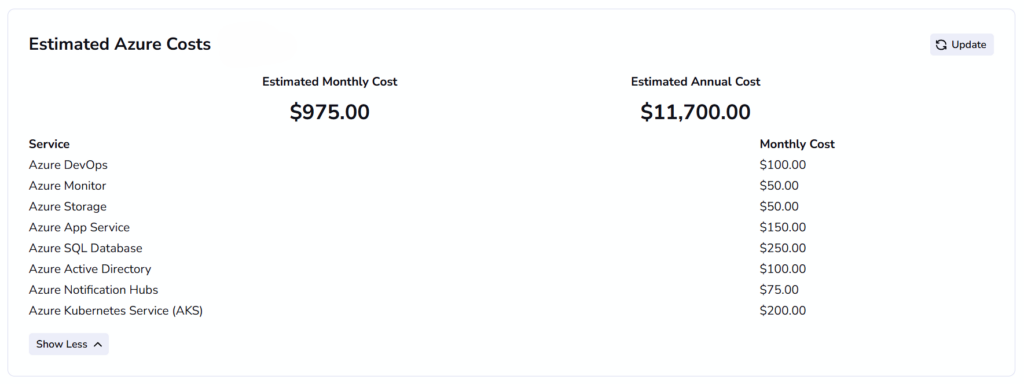New Crowdbotics Features Rounding Out The Platform
A host of exciting, new features greatly expand the capabilities of the Crowdbotics platform and solve common challenges for IT teams.
26 September 2024
Use AI to help you speed through the hardest part of modernization and maintenance: understanding how your system actually works.
Everything you need to be successful with Crowdbotics.
Use & Learn
We are on a mission to radically transform the software development lifecycle.
Crowdbotics uses AI to accelerate every step of the software development life cycle (SDLC)–starting with using AI to generate high-quality project requirements and progressing all the way through to deployment and monitoring. Today we’re announcing a broad set of features that improve different aspects of the SDLC. Taken together, these features greatly advance our goal of helping customers build apps faster and with less risk. There is a separate blog discussing the Technical Recommendations and Application Code Generation Features that can be found here. This blog covers some additional, important features also being delivered today.
PRD-AI, one of the foundational features of the Crowdbotics platform, uses AI to help business stakeholders generate high-quality product requirements documents (PRDs). PRD-AI ensures that every PRD comprehensively catalogs all of the business requirements, and those requirements are expressed with sufficient fidelity to ensure developers can infer the technical implementation without guessing at the stakeholder’s intent. The requirements generated by PRD-AI are specific to a single application. What about requirements that are common across a broad portfolio of applications? This is where the new Enterprise Context feature comes in.
Enterprise Context enables IT leaders and architects to define common corporate standards and policies that are applied when creating a new product requirements document (PRD). These can include the specification of development languages, frameworks, preferred APIs, cloud services, and regulatory and compliance requirements that must be enforced as common standards across applications.
Examples include specifying that all front-end development should be done with Java and React. Alternatively, an architect might specify that all web services should be written in C# using the .NET Framework. A healthcare organization’s compliance manager can note that all applications managing patient data must comply with HIPAA. Another use of Enterprise Context is to set specific cloud services as standards—for instance, using Microsoft Entra ID for authentication or Microsoft Azure SQL for managing structured data. Customers can use Enterprise Context to specify any time of standard or policy that might apply across their portfolio of apps.
This capability is a crucial addition for large enterprises building large numbers of apps. It’s also a powerful tool for system integrators seeking to maintain uniformity across a wide variety of projects. Enterprise Context ensures consistency and predictability across applications and improves the accuracy and speed of the PRD creation process.

As companies build more apps for the cloud and transition more legacy applications to the cloud, one of the biggest design challenges is understanding the cost implications of fundamental architecture choices – particularly when it comes to cloud runtime services. For instance, different database architectures can have varying impacts on downstream costs. Similarly, implementing serverless functions can have unintended cost implications if not managed properly.
Cloud hosting pricing models are complex, multifaceted, and difficult to predict. Without post-deployment runtime data, predicting future costs has been nearly impossible. It turns out, though, that all of the design and architecture information collected in a PRD provides a roadmap for new AI models to predict costs. Our new Cloud Consumption Cost Estimation capability leverages generative AI to predict monthly consumption costs for cloud-based applications.
By delivering cost data at the beginning of the project, this ground-breaking capability enables engineers to make critical decisions about architecture and design early in the development cycle, avoiding costly and hard-to-fix mistakes.

The Crowdbotics platform is designed to work seamlessly in concert with your existing DevOps investments in tools, infrastructure and processes. In keeping with that goal, we’ve added the ability to integrate with Jira and other project management platforms. This makes it easy for customers to turn their PRDs into project plans that are managed by Jira, Azure DevOps or any other project management platforms. PRD requirement steps can easily be turned into project plan work items.
Integrations like these ensure that customers can reap the productivity benefits of the Crowdbotics platform without impacting existing DevOps processes.
With the Azure Deployer, you can now deploy applications built with the Crowdbotics platform to the Azure Cloud with the push of a button. Managing deployments from a code repository (e.g., GitHub) into your runtime environment (e.g. your Azure instance) usually requires complex scripting and diligent management.
If you’ve built your application with the Crowdbotics platform, and your application is designed to run on Microsoft Azure, the platform enables you to build your app and deploy it to Azure without writing any Infrastructure as Code (IAC) or CI/CD pipelines. Crowdbotics manages this process and generates the infrastructure needed to support an out-of-the-box application. It’s as easy as hitting a ‘publish’ button and the platform handles all of the legwork. Crucially, all subsequent updates are just as seamless, using the same streamlined approach.
Crowdbotics has set out to help customers supercharge their SDLC by strategically applying AI across each step of the process. Each of these new features tackles a specific challenge that customers face at different stages of the SDLC. Together, they add up to more productivity, more predictability and less when it comes to building enterprise applications. We’re proud of this latest batch of new Crowdbotics platform features, and we’re excited about all of the cool stuff still to come.